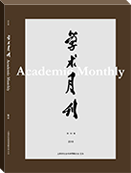Citation:
An Analysis on the Toponyms on Han Dynasty’s Western Frontier[J]. Academic Monthly, 2018, 50(03).

An Analysis on the Toponyms on Han Dynasty’s Western Frontier
-
Abstract
Tribute of Yu ( yugong, 《禹贡》) is not only a historical text of geography knowledge of the Pre-Qin period, but also a thinking mode for the ancient people to recognize their geographical environment. Since the Emperor Wu of Han’ s conquest of Hexi Corridor and his expansion in the southwest of China, people of the Han Dynasty started to naming the new mountains and rivers with toponyms such as Sanwei(三危) , Ruoshui (弱水), and Heishui(黑水) which belong to Yongzhou(雍州) and Liangzhou(梁州) in Tribute of Yu, while the Old Text School played big role. Benefiting from the classical legitimacy of Tribute of Yu, these news mountains and rivers were treated as if they were attached to the ancient Chinese regime since the period of Yu the Great (dayu, 大禹). Meanwhile, the Han people’s knowledge of Yongzhou and Liangzhou had changed. Hexi Corridor, for example, was usually considered as a part of Yongzhou from time immemorial, and the enlarged Yizhou(益州), a result of the expansion of the Qin and Han Dynasties, was simply seen as Liangzhou in Tribute of Yu. Moreover, in order to create an impression that Yizhou was always in Chinese culture zone, Turtle Beak (zi, 觜)and Three Stars(can,参), two of the Twenty-Eight Mansions, which initially matched the region of the state of Wei(a member of the Warring States), were allocated to Yizhou
-

-
References
-
Access
-
-
[1]
. . Academic Monthly,
2017, 49(06): 111-119.
-
[2]
Jun XUE
. Declaration of Behavior Ability in Chinese Law: Connotation of System and Reconstruction of Theory of Interpretation. Academic Monthly,
2019, 51(12): 95-105.
-
[3]
. . Academic Monthly,
2017, 49(11): 79-115.
-
[4]
. . Academic Monthly,
2016, 48(10): 153-163.
-
[5]
. . Academic Monthly,
2017, 49(02): 13-18.
-
[6]
. . Academic Monthly,
2016, 48(07): 5-19.
-
[7]
Dali YAO
. The Basic Attributes of the China’s Frontiers. Academic Monthly,
2019, 51(2): 176-184.
-
[8]
. . Academic Monthly,
2016, 48(09): 110-124.
-
[9]
Jianyong FENG
. The “Local” Pattern and the Meaning of “World” of Borderland. Academic Monthly,
2018, 50(12): 166-175.
-
[10]
Yujie FENG
. The Imitation and Transformation of Impartation Rituals of the Medieval Daoism from the Emperor’s Enthronement Rites of the Han Dynasty. Academic Monthly,
2019, 51(5): 168-184.
-
[11]
Zengguang LIU
. “Original Body” and Metaphysical Dimension of Body. Academic Monthly,
2019, 51(5): 24-31.
-
[12]
. . Academic Monthly,
2017, 49(12): 172-179.
-
[13]
Jingping ZHANG
. Lasting Impact of Tuntian System in Frontier Social Changes in Modern Time. Academic Monthly,
2021, 53(5): 186-201.
-
[14]
. . Academic Monthly,
2017, 49(12): 25-32.
-
[15]
. . Academic Monthly,
2018, 50(01): 5-28.
-
[16]
Jianyong FENG
. “Diplomatizing” the Border Governance. Academic Monthly,
2023, 55(2): 186-198.
-
[17]
HUANG Dayuan
. . Academic Monthly,
2023, 55(12): 199-203.
-
[18]
YAO Dazhi
. On the Base of Rights. Academic Monthly,
2023, 55(9): 5-13.
-
[19]
Zhirong Zhu
. On the View of Imagery in Zhouyi. Academic Monthly,
2019, 51(2): 124-1.
-
[20]
. . Academic Monthly,
2017, 49(04): 28-41.
-
-



 沪公网安备 31010102003103号
沪公网安备 31010102003103号 DownLoad:
DownLoad: